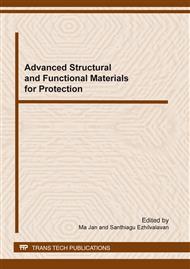p.48
p.51
p.55
p.60
p.65
p.69
p.73
p.77
p.81
Novel Piezoelectric Tactile Sensor Materials with Improved Properties
Abstract:
Lead Zirconium Titanate (PZT) is an example of a piezoelectric material, which can be polarized by an electric field or mechanical stress. This study aims to establish how doping PZT with Strontium will result in PSZT thin films with improved piezoelectric properties for biomedical tactile sensor applications. Various thin film samples were fabricated via sol-gel & spin-coating processing methods-PZT (4 layers), PSZT (4 layers), PSZT-PZT (2L PSZT base-2L PZT) and PZT-PSZT (2L PZT base-2L PSZT), analyzed by X-Ray Diffraction (XRD) and Atomic Force Microscopy (AFM) to determine crystalline structure and surface morphology, and by a ferroelectric analyzer to determine leakage current characteristics and ferroelectric parameters such as Pmax, Pr and Vc (representation of piezoelectric properties). The addition of Strontium retains the perovskite structure of PZT and marginally influences the ferroelectric properties. Among the hybrid films, PZT(base)-PSZT showed better ferroelectric characteristics (higher Pmax and Pr values). A mathematical relationship between the ferroelectric parameters (Pr and Vc) to evaluate the films quality factor in relation to their application as tactile sensors, was also established, from which it was concluded that PZT-PSZT performs much better than the other 3 films for such applications despite high Vc values. The improved performance of hybrids may be due to the evolved microstructure and crystalline structure. Present investigation resulted in two important conclusions: PZT-PSZT hybrid films are ideal for tactile sensor applications, and the mathematical relationship developed can be used to evaluate any piezoelectric/ferroelectric materials.
Info:
Periodical:
Pages:
65-68
Citation:
Online since:
February 2012
Authors:
Price:
Сopyright:
© 2012 Trans Tech Publications Ltd. All Rights Reserved
Share:
Citation:


